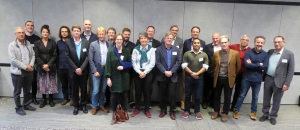Polyglucosan storage myopathies
- Number 251
- Date 13 December 2019
251st ENMC International Workshop
Location: Hoofddorp, the Netherlands
Title: Polyglucosan Storage Myopathies
Date: 13-15 December 2019
Organizers: Anders Oldfors (Sweden), Pascal Laforêt (France), Edoardo Malfatti (France), John Vissing (Denmark)
Translations of this lay report:
French by Prof. P. Laforêt
Spanish by Prof. J. Guinovart
Catelan by Dr J. Duran
Danish by Prof. J. Vissing
Swedish by Prof. A. Oldfors
Hebrew by Prof. O. Kakhlon
Participants: M. A. Colle (France), J. Duran (Spain), M. Gentry (USA), J. Guinovart (Spain), T. Hurley (USA), O. Kakhlon (Israel), T. Krag (Denmark), H. Landy (USA), P. Laforêt (France), C.B. Lilleør (Denmark), E. Malfatti (France), B. Minassian (Canada/USA), F. Mingozzi (France), E. Murphy (UK), A. Oldfors (Sweden), R. Piercy (UK), M. Piraud (France), V. Ramanan (USA) M. Stemmerik (Denmark), C. Thomsen (Sweden) J. Vissing (Denmark), M. Weil (Israel)
Twenty-one participants, including one patient representative and three industry representatives, from European countries, USA, Canada and Israel attended the 251st ENMC sponsored workshop focusing on polyglucosan storage myopathies.
Polyglucosan storage myopathies are a group of glycogen storage diseases with accumulation of polysaccharides that are less branched than normal glycogen. These polysaccharides form inclusion bodies in the muscle fibers that are the pathological hallmarks of the diseases, which comprise a group of less than ten different genetically characterized entities. Although the diseases have the muscle polyglucosan storage in common some of them affect also other tissues, which in some cases cause the main symptoms.
The aim of the ENMC workshop was to create a multidisciplinary forum for discussion between clinical and basic researchers working on polyglucosan storage-related issues. The attending experts discussed recent discoveries of new and established disease entities, their genetic background and pathophysiological mechanism. This was followed by discussions about pharmacological or gene treatment options derived from current knowledge of disease mechanisms. Several animal models were described and the promising results from preclinical treatment studies in these animal models with the aim to reduce the amount of polyglucosan storage to cure the disease or prevent its progression. Major benefits of this workshop for patients with polyglucosan storage myopathies include exchange of knowledge amongst participating experts with establishment of new scientific collaborations leading to improved diagnostic possibilities and intensified efforts to promote preclinical and clinical treatment investigations.
Extract from the application to ENMC to have this workshop:
WORKSHOP DELIVERABLES
- Summary and update on clinical conditions associated with polyglucosan accumulation
- Update on the current concepts regarding glycogenin and glycogen synthesis
- Comprehensive overview of myopathies with polyglucosan accumulation
- Setting up future research on pathophysiology and treatment in myopathies with polyglucosan accumulation.
Questions to focus on in the workshop include:
- Nature of polyglucosan: its composition and biochemical characteristics
- Diseases with polyglucosan accumulation – old and new entities
- Morphological analyses of different polyglucosan disorders
- Molecular mechanisms that lead to accumulation of polyglucosan
- Clinical and pathological phenotyping of different polyglucosan disorders
- Genotype-phenotype correlation in patients with glycogenin-1 deficiency
- Glycogen synthesis in the absence of glycogenin-1. Role of glycogenin-2
- Strategies for molecular treatment of polyglucosan accumulation
Aims and objectives:
- To precisely characterize the nature of polyglucosan: morphological features, biochemical composition, and molecular mechanisms that lead to accumulation of polyglucosan
- To constitute a multidisciplinary consortium of experts in polyglucosan storage myopathies
- To define the incidence and prevalence of polyglucosan storage myopathies
- To elaborate strategies for treatment of polyglucosan accumulation
The participants of the 251th ENMC workshop on polyglucosan storage myopathies

The full report is published in Neuromuscular Disorders (PDF)
